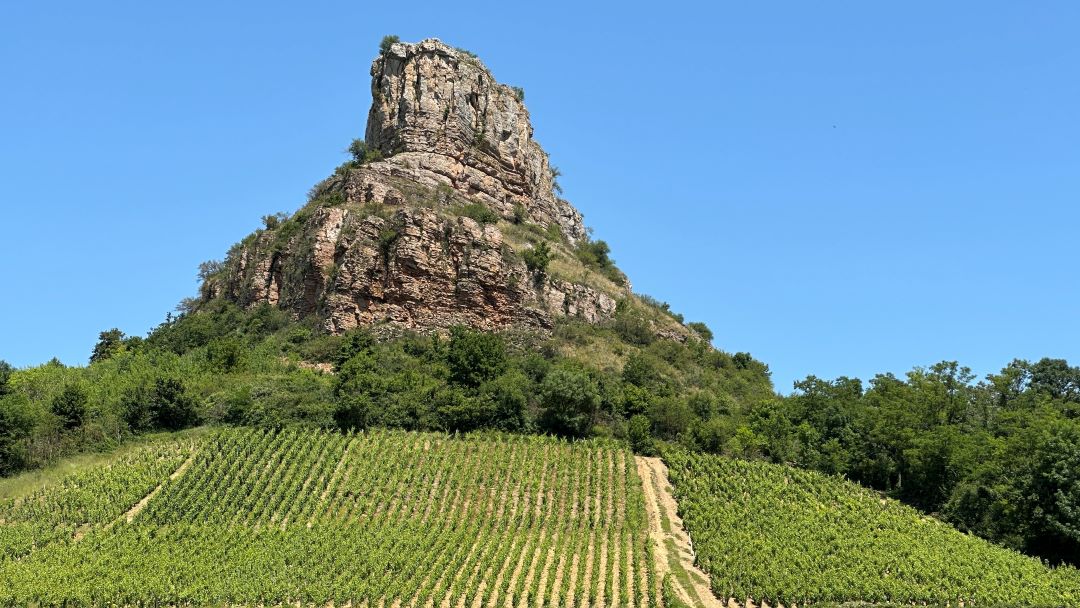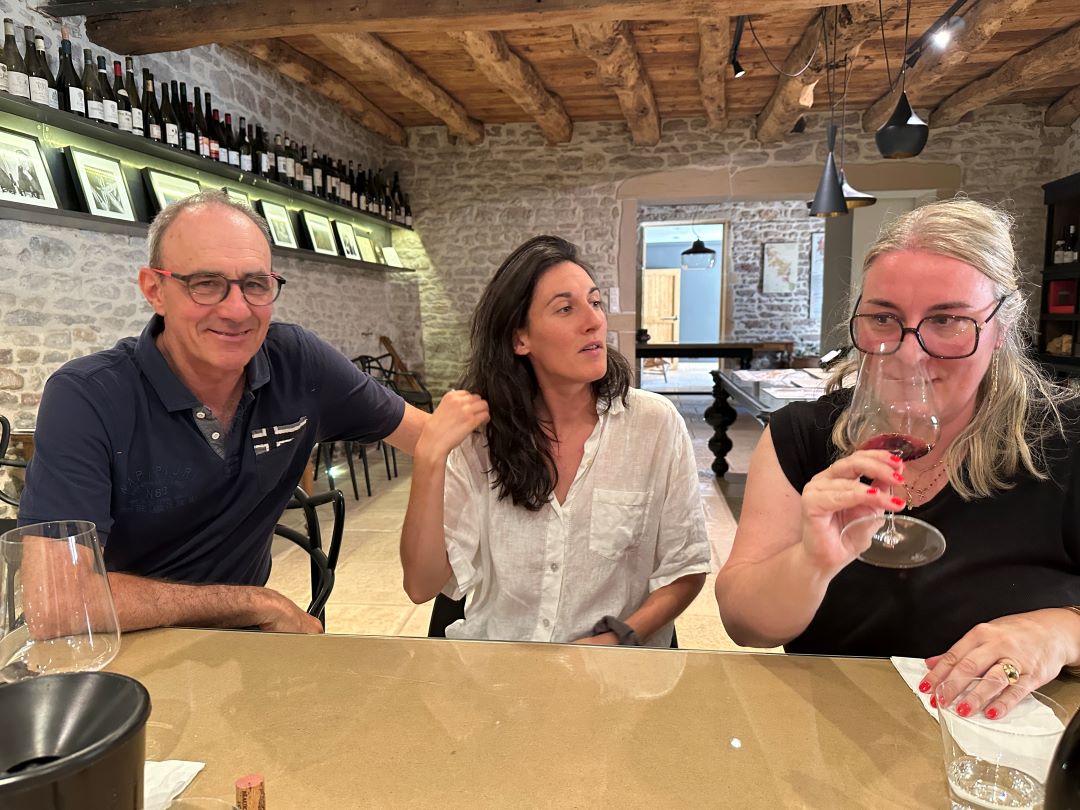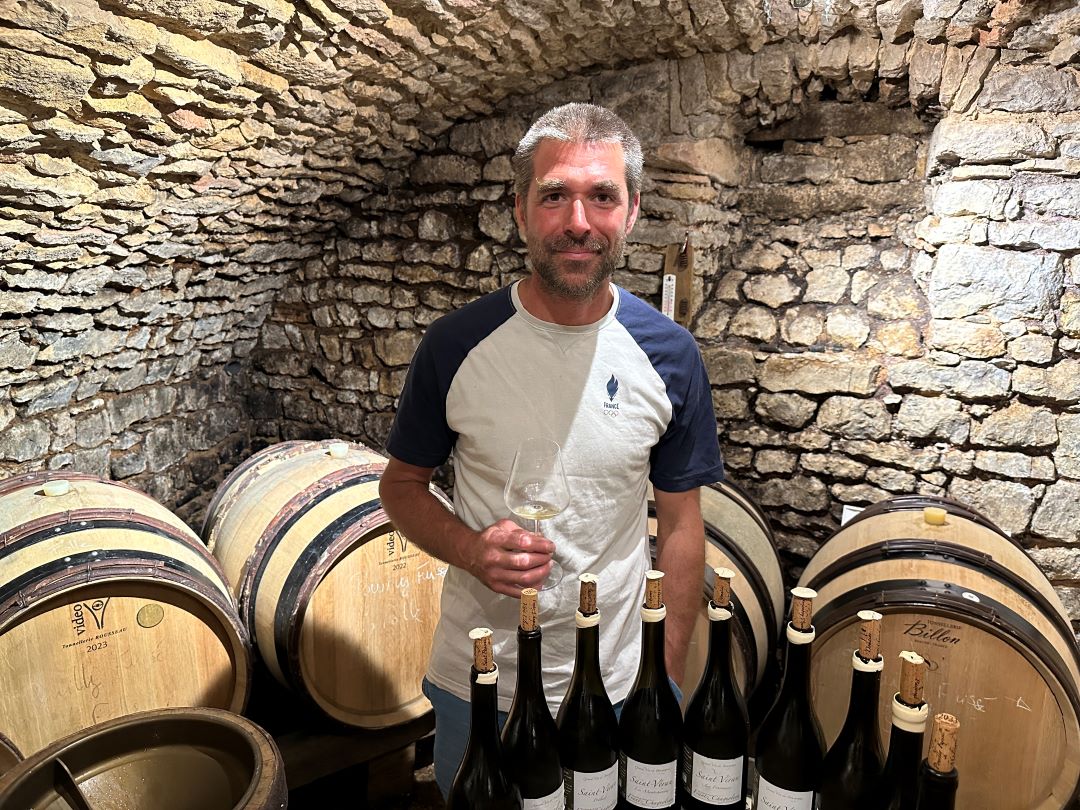Browse using the new Vinous website now. Launch →
Printed by, and for the sole use of . All rights reserved © 2015 Vinous Media
Tail Fin Delights: Mâconnais 2023/2024
BY NEAL MARTIN | AUGUST 14, 2025
Every June, I make two trips to the north and south of Burgundy. Two hundred kilometres and the Côte d’Or lie between Chablis and Mâconnais, but these regions merit juxtaposition. Chablis’ northerly knife-edge latitude exposes its vines to cooler temperatures and theoretically more inclemency, whereas Mâconnais is slightly warmer. Chablis comprises rolling hills adrift in France’s rural expanse. Mâconnais is a more dramatic landscape with tighter contours, punctured by the Roches de Vergisson and Solutré that erupt like ochre-stained tail fins on a fifties Cadillac. Unlike somnolent Chablis, Mâconnais has a lively town on its doorstep. Chardonnay is the paintbrush for both regions, albeit using different canvases, with Chablis distinguished by Kimmeridgian soils and Mâconnais more diverse underfoot, predominantly limestone with varying degrees of clay. Perhaps one key difference is that whilst everyone knows what Chablis is, Mâcon’s wines are less recognised beyond Pouilly-Fuissé. Even that is often conflated with Pouilly-Fumé, this despite recent Premier Cru promotions.
The Roche de Solutré forms one of two “tail fins” in the Mâconnais.
Mâconnais is a treasure trove of vinous delights that deserve wider appreciation and certainly should not be regarded as an afterthought when considering what Burgundy brings to the table. In fact, given some of the inflated prices elsewhere, Mâconnais deserves to be at the forefront of wine lovers’ minds.
The Growing Season
Allow me to replicate my 2023 summary from last year’s report, since that vintage is the focus of my tasting notes.
The 2023 growing season commenced with a relatively mild January, with temperatures averaging around 5.1°C. The following weeks were changeable, alternating between spells of freshness and warmth. February was absurdly dry, with just 2mm of rain recorded. Budding was around April 2, similar to 2009 and 2016, a little earlier than usual. April turned out to be colder than normal, averaging 11.1°C, though that is the highest of any region of Burgundy. It wasn’t until the end of the month that conditions improved, with May witnessing average temperatures of 16.4°C. Henceforth, vines seemed to compensate for lost time and grew rapidly with a swift mi-floraison recorded as of June 2 under slightly warmer conditions than average, 22.0°C. This uninterrupted and even flowering foregrounded a large volume of fruit.
Vineyard managers had to remain vigilant. Outbreaks of rain provided ideal conditions for powdery and downy mildew, both constant threats. The Mâconnais was deluged with 130 mm in June, almost twice that of the Côte d’Or at 78 mm. Bunches closed in early July, four or five days before normal, and the usual uptick in warmth never happened, the mercury nudging just 0.1°C warmer. This was concurrent with the onset of dry conditions, and vines already facing a water deficit were under tremendous stress. Outbreaks of showers towards the end of August offered only minor relief, notwithstanding sporadic localized hail.
The result was that some areas of the Mâconnais struggled to fully ripen their fruit as vines closed down to survive. Most pickers went out on September 11, although a few started two or three days earlier. Thankfully, the weather was bright and sunny, with temperatures warmer than usual at 20.3°C and cool nights that helped preserve acidity. That month witnessed 264 sunlight hours, far higher than normal, so there was around 15% more sunshine over the growing season. These clement conditions ushered most of the fruit to full maturity.
Pressings tended to be gentle because winemakers found less juice than expected, with the final vins de presse excluded in order to retain low pH levels. With regard to élevage, some producers shared that they opted to extend the length of barrel maturation, partly to enhance the wines but also because there was free space in the cellar after the shortfall in quantity.
Having recently published my report on Chablis, it should come as no surprise that 2024 was a traumatic season. Though it was not an easy vintage by a long chalk, Mâconnais was not quite as impacted as the Côte d’Or or Chablis. April saw the mercury slide to -2°C, which caused frost damage in exposed spots. Hail generally avoided the Mâconnais throughout the year, as thunderstorms tended to break out either east or west of the region. Temperatures were below average, but not quite as cold as elsewhere, which can make all the difference in terms of ripening. Compare, for example, average temperature in June: 18.0°C in Chablis but 19.3°C in Mâcon, whilst August averaged 22.9°C in Mâcon. That said, the region was deluged throughout the year: 146 mm in March and 91 mm in May, though again, that is far less than the 196 mm recorded in Chablis. Consequently, there was widespread coulure and millerandage, though this could assist concentration. The 30 mm of rain in August was markedly less than in the 87 mm in the Côte d’Or. Mâcon was also blessed with 328 sunlight hours, more than Côte d’Or and Chablis. Of course, this led to a later growing cycle. Even though budding on March 31 was around a week earlier than normal due to a warm February, by the time of véraison, the growth cycle was lagging nine days behind. Because of these minor but important disparities, sugar accumulation was better here, comparable to the Chardonnay in the Côte de Beaune. There was a week of rain in early September, with many pickers entering vineyards around September 12 in cooler conditions compared to recent years. Yields were not as impacted as other regions; for example, Château de Fuissé reported 52 hl/ha.
Incidentally, whilst Chablis seemed to take the brunt of the challenging conditions in 2024, 2025 appears to be Mâconnais’ turn. A localised hailstorm barrelled across some of the prime vineyard sites—such as Fuissé and Solutré—during budbreak, and subsequent mildew pressure was intense. Potential shortfalls in 2025 production may influence buying decisions of 2023s and 2024s.
The Tastings
Unlike my time in Chablis, during which I undertake tasting with the BIVB, in Mâconnais, my days are filled with visits to wineries only. Due to mildew pressure, it was all-hands-on-deck, and a couple of producers missed our appointments as they were out on their tractors. Perhaps the most notable was Domaine Barraud in Vergisson, as Julien Barraud was preoccupied treating his vines during the spell of dry weather. I will endeavour to visit at a later date, as I admire Barraud’s wines.
Many visitors overlook Mâconnais and flock to the Côte d’Or, but they are missing out on the most picturesque part of Burgundy, speckled with some wonderful bistros and one of my favourite boulangeries in the village of Leynes. Shop spaces have hollowed out the main town of Mâcon, but there are some excellent places to eat. On this trip I discovered La Dama—a wonderful bijou Italian restaurant with a tempting and well-priced wine list—plus a new wine shop, Racines, stocked with a fine selection from artisan winemakers with wines available to drink by the glass.
The Wines
General sentiment towards the 2023 vintage seems to have improved since I tasted a smattering of barrel samples 12 months ago. Now that the wines are in bottle, winemakers have warmed to them. Perhaps the 2023s might not possess the vaulting ambition of the concentrated 2022s, a comparison that initially painted the 2023s in a less favourable light, but their drinkability is a virtue. No, these are not the most complex Mâconnais wines, but since bottling, they have evolved more nerve and a soupçon more complexity. The 2023s were aided by relatively moderate yields compared to the Côte de Beaune, and the best terroirs in Mâconnais show their mettle with fresh, pleasingly tensile wines that brim with nascent vigour. Even at the top of the hierarchy, the best Pouilly-Fuissé wines tend to be geared for early consumption. However, if you do intend to cellar them, they will drink earlier than their 2022 counterparts.
From left to right, Christophe Thibert, daughter Camille, and sister Sandrine Thibert-Needham.
Obviously, like in other regions, the 2024s are going to be thin on the ground, though not to the same degree as the worst-affected parts of the Côte d’Or and Chablis. Volume does not preclude quality, and many winemakers seem positive about these wines currently gestating in barrel. The handful that I tasted from the likes of Château de Fuissé and J-A Ferret look promising, but I will get a better handle on them next year. It will be intriguing to see whether, as Ferret’s winemaker Clément Robinet suggested, there is disparity between Fuissé and Vergisson, the latter purportedly more linear in style. We will see.
In terms of the market, Mâconnais has benefitted from the Premier Cru promotion of Pouilly-Fuissé from the 2020 vintage. The recent promotions of Pouilly-Vinzelles and Pouilly-Loché only apply from the 2024 vintage onward, so it will be a few years before we see whether they gain more recognition, which currently lags behind Pouilly-Fuissé due to size and perhaps lack of well-known growers. That said, it is beneficial for the entire region that there are now multiple appellations with Premier Cru status.
Frédéric Burrier relaxing whilst I tackle a wide-ranging portfolio, including his Beaujolais from “across the border.”
“The market is good in Europe but difficult in the United States because of tariffs,” Frédéric Burrier told me, before the 15% tariff agreed between the United States and the E.U. on July 27, then again, maybe that will be rescinded by the time this report is published! “France is also difficult, as people are not spending so much on wine. It's not dynamic, but it's not a bad period.” Olivier Merlin had similar sentiments: not an easy period for sales, but there is at least more recognition for the region. I do not yet detect much drifting away from Côte de Beaune to Mâconnais as cash-strapped consumers are priced out of the former’s best vineyards and/or producers. There remains a bit of prejudice against Mâconnais wines, and consumers seem hidebound to their favoured appellations and unwilling to swap, say, Puligny for Pouilly-Fuissé. Even though in terms of status there is now more parity, it takes time for consumers to revise their occasionally unjustified lack of appreciation. One Burgundy expert recently opined that a Premier Cru in the Mâconnais could never achieve the same level as a top Meursault or Puligny. Whilst I might agree that the very pinnacle might be unattainable, I would argue that a top Pouilly-Fuissé Premier Cru can match many Puligny Premier Crus. The difference is that the Pouilly-Fuissé wines have a slightly creamier texture and rarely achieve the same degree of mineral intensity.
Together with wife Caroline Gon, Frantz Chagnoleau furnishes wine lovers with some of the finest Saint-Véran.
Perhaps the one appellation that remains underappreciated is Saint-Véran. That is partly because cooperatives churn out mediocre fare that risks tarnishing the name. For that very reason, it is unlikely that Saint-Véran’s best lieux-dits will one day gain promotion, since it is in their interest to maintain low prices. Nevertheless, in the right hands, Saint-Véran can be wonderful. Check out Frantz Chagnoleau, Dominique Cornin, Domaine La Soufrandière, Domaine de la Croix Senaillet, not forgetting, of course, the enfant terrible himself, Jean-Marie Guffens. Perhaps Saint-Véran is destined to always be the bridesmaid and never the bride, but its wines represent outstanding value in today’s market.
Final Thoughts
It sounds a bit banal, but I feel that Mâconnais is “chugging along nicely.” Producers here see how the Côte d’Or has changed in recent years, for better and for worse. They don’t yearn for the stratospheric prices now seen for either the Côte d’Or vineyards or some of its wines, those in Mâconnais bristling at the notion of redefining wine as a desirable luxury item. Mâconnais wine is to be consumed. That is its raison d’être, and there is no deviating from that cause. Premier Cru status has given the region some status “glitter,” although that has not led to overnight fame for its elevated vineyards. But it has prompted some to view the wines more seriously, which will yield long-term benefits. Perhaps with quantities depleted elsewhere in 2024, it’s the perfect moment to drink more wines from the Mâconnais. They have much to offer. There’s delight to be found around those tail fins.
© 2025, Vinous. No portion of this article may be copied, shared or redistributed without prior consent from Vinous. Doing so is not only a violation of our copyright but also threatens the survival of independent wine criticism.
You Might Also Enjoy
Mâconnais 2022/2023: Don’t Pass Me By, Neal Martin, August 2024
Moving On Up: Mâconnais 2021 & 2022, Neal Martin, August 2023
The Inflection Point: Mâconnais 2020 & 2021, Neal Martin, August 2022
Don’t Rain on My Parade: Mâconnais 2019/2020, Neal Martin, November 2021
Show all the wines (sorted by score)
- Bret Brothers
- Château de Beauregard
- Château de Fuissé
- Château des Quarts
- Château des Rontets
- Château du Clos
- Domaine Cheveau
- Domaine Christophe Thibert
- Domaine de la Chapelle (Catherine & Pascal Rollet)
- Domaine de la Croix Senaillet
- Domaine de la Rochette
- Domaine Dominique Cornin
- Domaine du Mont Épin
- Domaine Frantz Chagnoleau
- Domaine Guffens-Heynen
- Domaine Guillemot-Michel
- Domaine J-A Ferret
- Domaine Joseph Burrier
- Domaine La Soufrandière
- Domaine Michel
- Domaine Olivier Merlin
- Domaine Robert Denogent
- Domaine Roc des Boutires
- Domaine Saumaize-Michelin
- Famille Paquet
- Famille Vincent
- Jules Desjourneys
- Maison Joseph Burrier
- Maison Verget
- Marcel Couturier
- Simon Faure




